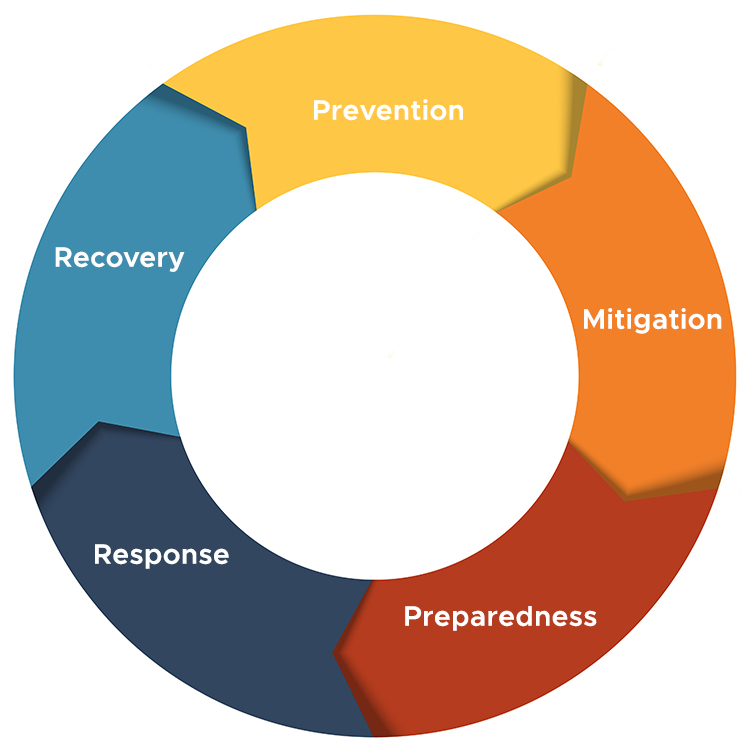KERAMIDA's emergency management consultants provide crisis management and emergency response planning and training to ensure companies have the resources necessary to successfully handle worst-case scenarios.
KERAMIDA has developed Crisis Management and Emergency Response Plans for power plants, manufacturing facilities, distribution centers, and utilities, worldwide.
Our Crisis Management & Emergency Response Services include:
Crisis Management and Business Continuity Planning
Crisis management plans are the process by which an organization deals with a major event that threatens to harm the organization, its stakeholders, or the general public. Crisis management planning is considered to be the most important process in public relations today. A well-defined and executed crisis response plan is a key component in maintaining business continuity, and will significantly minimize the damage to organizational credibility in both the financial and public sectors.
KERAMIDA's crisis preparedness experts are able to assist businesses in developing a comprehensive crisis management plan that defines the critical roles and responsibilities for each of the specific business groups necessary to effectively manage the crisis and maintain business continuity.
Emergency Response Plans
Having an emergency response plan in place is critical to the safety and security of site employees, contractors, visitors and responding agencies in all types of businesses. Knowing how to react in the moments immediately following a catastrophic event is paramount; issuing a timely warning to evacuate, shelter-in-place or lockdown can save lives. Implementing an integrated emergency response plan will reduce confusion, provide coordinated efforts to keep facility personnel safe and informed, minimize site damages and financial impact, and help maintain business continuity.
Prevention • Mitigation • Preparedness • Response • Recovery
We work with each business or organization to organize, draft, and implement an emergency response plan that specifically addresses all the potential emergency scenarios. Our expert crisis response trainers provide employee training in a clear, easy-to-follow way, to ensure that employees come away fully understanding the security protocols for each type of emergency.
Our Emergency Response Consulting Services include:
Comprehensive safety plans to address all significant emergencies with the potential of impacting worker safety.
Regulatory required Risk Management Plans to protect worker safety, public health, and the environment.
Incident and response tracking for compliance reporting and continuous improvement.
Chemical Facility Anti-Terrorism Standards (CFATS) Compliance Guidance
KERAMIDA's experienced team of safety professionals includes a Chemical-Terrorism Vulnerability Information (CVI) Authorized User. We help industrial facilities across the U.S. address all aspects of CFATS compliance and safety issues, including developing a Site Security Plan, Alternative Security Plan or other plan applicable to the Tier level of your facility that meets the criteria in Risk-Based Performance Standards (RBPS).
Our CFATS Compliance Support Services include:
Overall support for the reporting process
Top-Screen and Site Vulnerability Assessments
Developing applicable policies and procedures
Developing a Site Security Plan (SSP)
CFATS Specific Training
Preventing Workplace Violence
Factors that are critical in preventing workplace violence in an organization include:
Strong leadership that identifies the need for awareness and clearly supports being proactive against any form of violence in the workplace
An established safety culture that is fully integrated and personally owned by everyone
A zero-tolerance policy that enforces disciplinary and corrective actions
A written Workplace Violence Prevention Program that defines workplace violence and establishes organizational preparedness through policy, procedures, and a code of conduct
This program would also provide a foundation for awareness regarding specific key behaviors and contributing factors that are more predictive of violence
Reporting procedures and training protocols would be included as well
Physical security in the form of a secured building with only authorized access
Recognition of the human factor and demonstration of such
Workplace Violence Prevention Plans
It is important that all employers have a written Workplace Violence Prevention Plan (WVPP) developed and implemented so that any scenario may be effectively responded to. Per the OSHA General Industry Clause, organizations have a responsibility to their employees to provide a safe working environment free from recognized hazards that are causing or are likely to cause death or serious harm. Therefore, organizations can be held liable for not taking the necessary measures to protect their employees. The consequences of such a failure can be devastating regarding cost, reputation and loss of quality employees.
KERAMIDA's risk management professionals assist organizations by preparing Workplace Violence Prevention Plans (WVPP), performing property threat/vulnerability assessments, and providing awareness training. These Plans are in accordance with California’s Labor Code Section 6401.9 and include industry-specific best management practices. ** NOTE: Unless exempt, California requires employers to establish, implement, and maintain a written Workplace Violence Prevention Plan (WVPP) by July 1st, 2024.
Workplace Violence Prevention Plan (WVPP) Requirements
A Written Workplace Violence Prevention Plan (WVPP) includes the following minimum requirements:
Designation of persons deemed responsible for the Plan
Procedures for involvement of employees and authorized employee representatives in developing and implementing the Plan
Methods for coordinating the implementation of the Plan throughout all departments
Procedures for reporting workplace violence internally and externally with law enforcement
Procedures for effective communication with employees regarding workplace violence matters
Procedures for responding to actual and/or potential workplace violence emergencies
Procedures for training employees
Procedures for identifying, evaluating, and correcting workplace violence hazards
Procedures for post-workplace violence incident response and investigation
Procedures for routine review of the Plan and revising it, as necessary
Maintenance of violent incident log and provision of respective training
Procedures to ensure overall compliance with the Plan
Additional WVPP components may include but not be limited to the following:
Establishment of Zero Tolerance Policy
Assignment of roles and responsibilities of personnel
Development of an Employee Assistance Program (EAP) and support services
Conflict resolution
Protocol for high-risk terminations
Active shooter emergency response
Physical security
Camera and/or video surveillance
On-site Threat/Vulnerability Assessment and Risk Analysis include:
Review of Workplace Violence Prevention Plan and other pertinent documentation
Confirmation that employees are being trained on the Workplace Violence Prevention Plan
Evaluation of physical security, perimeter controls, parking lots, entryways, and exits
Confirmation of assigned roles and responsibilities for personnel
Evaluation of camera/video surveillance placement
Evaluation of badge and scan systems
Demonstration of personnel, visitor, and contractor accountability
Blind spot identification
Identification and evaluation of facility alarms, notification, and communication methods
On-site and Remote Workplace Violence Awareness Training
Classroom presentation
Virtual
Workplace Violence Awareness and Active Shooter Preparedness Training
There is a growing need for vigilance to be taken across the United States regarding workplace violence and active shooter potential. Due to past and more recent events, it is apparent that a proactive stance on this must be taken by businesses, schools, and other organizations.
Workplace violence can occur in any place where two or more people work together. It can be the result of a disagreement, bullying, domestic dispute, mental illness, terrorism, or an unknown cause. An active shooter event can occur anywhere, as well as anytime, and often without warning. Education and mental health awareness can help identify and prevent a situation from escalating to violence in the workplace, but it must also be combined with preparedness and response training in order to fully equip employees with the resources that will help them stay safe.
Established in 1988, KERAMIDA is a full-service emergency management consulting firm, providing environmental, sustainability, health and safety, and emergency response planning and tracking services. Our crisis management professionals are prepared to assist organizations in developing a workplace violence prevention plan, which includes workplace active shooter response training to all employees.
Workplace Violence Awareness and Prevention Training includes:
Definition of what workplace violence is
Reviews of case studies and statistics
Advice on proactive steps that should be taken as an organization
Warning signs or patterns of behavior to look out for, and how to foresee potential violence
Guidance on what to do if you suspect a violent act may occur
Strategies on how to prevent workplace violence from happening
Clear, effective response measures to all types of violent acts
Active Shooter Preparedness Training:
Clarifies what constitutes an active shooter event
Identifies potential warning signs
Provides employees best options, and training on how to survive an active shooter situation
Lists guidelines for police interaction during an active shooter event
In an active shooter situation, be prepared to:
For large businesses or organizations that require training for 40+ employees, KERAMIDA has established a training partnership with Carol Cambridge, who specializes in providing Workplace Violence and Active Shooter Preparedness training in a large-scale format. Ms. Cambridge has 25 years of experience in the field, and is a recognized authority on workplace violence, workplace conflict, and personal safety, having taught over 150,000 people on how to make good decisions and ensure a safe workplace.
KERAMIDA offers several different 1-2 hour training seminars in partnership with Ms. Cambridge. To learn more about the most popular Workplace Violence Prevention training programs available, please see below.
Implementing workplace violence awareness plans and providing active shooter response training for employees is essential for all businesses and organizations, including:
Manufacturing facilities
Management
All plant and office personnel
Contractors, suppliers and/or vendors
Schools
Administration
Teachers
Students
Government (City, Local, State, Federal)
Officials
Management
All personnel
Public Gathering Places
Shopping Malls
Entertainment Venues
Sports Arenas
Related Services:
KERAMIDA is a leading health and safety services firm with decades of EHS experience. We help companies manage risk, assure OSHA compliance, and improve health & safety performance. We are experts in silica exposure, H&S program development, ISO 45001 Occupational Health & Safety MS, audits, and training.





















